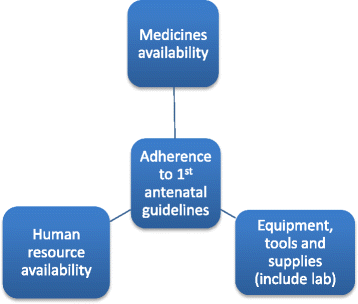Public health facility resource availability and provider adherence to first antenatal guidelines in a low resource setting in Accra, Ghana
- PMID: 27654404
- PMCID: PMC5031339
- DOI: 10.1186/s12913-016-1747-1
Public health facility resource availability and provider adherence to first antenatal guidelines in a low resource setting in Accra, Ghana
Abstract
Background: Lack of resources has been identified as a reason for non-adherence to clinical guidelines. Our aim was to describe public health facility resource availability in relation to provider adherence to first antenatal visit guidelines.
Methods: A cross-sectional analysis of the baseline data of a prospective cohort study on adherence to first antenatal care visit guidelines was carried out in 11 facilities in the Greater Accra Region of Ghana. Provider adherence was studied in relation to health facility resource availability such as antenatal workload for clinical staffs, routine antenatal drugs, laboratory testing, protocols, ambulance and equipment.
Results: Eleven facilities comprising 6 hospitals (54.5 %), 4 polyclinics (36.4 %) and 1 health center were randomly sampled. Complete provider adherence to first antenatal guidelines for all the 946 participants was 48.1 % (95 % CI: 41.8-54.2 %), varying significantly amongst the types of facilities, with highest rate in the polyclinics. Average antenatal workload per month per clinical staff member was higher in polyclinics compared to the hospitals. All facility laboratories were able to conduct routine antenatal tests. Most routine antenatal drugs were available in all facilities except magnesium sulphate and sulphadoxine-pyrimethamine which were lacking in some. Antenatal service protocols and equipment were also available in all facilities.
Conclusion: Although antenatal workload varies across different facility types in the Greater Accra region, other health facility resources that support implementation of first antenatal care guidelines are equally available in all the facilities. These factors therefore do not adequately account for the low and varying proportions of complete adherence to guidelines across facility types. Providers should be continually engaged for a better understanding of the barriers to their adherence to these guidelines.
Keywords: Adherence; Facility factors; First antenatal care; Guidelines; Providers; Support.
Figures
Similar articles
-
Provider adherence to first antenatal care guidelines and risk of pregnancy complications in public sector facilities: a Ghanaian cohort study.BMC Pregnancy Childbirth. 2016 Nov 24;16(1):369. doi: 10.1186/s12884-016-1167-6. BMC Pregnancy Childbirth. 2016. PMID: 27881104 Free PMC article.
-
Client Factors Affect Provider Adherence to Clinical Guidelines during First Antenatal Care.PLoS One. 2016 Jun 20;11(6):e0157542. doi: 10.1371/journal.pone.0157542. eCollection 2016. PLoS One. 2016. PMID: 27322643 Free PMC article.
-
Adherence to standards of first-visit antenatal care among providers: A stratified analysis of Tanzanian facility-based survey for improving quality of antenatal care.PLoS One. 2019 May 13;14(5):e0216520. doi: 10.1371/journal.pone.0216520. eCollection 2019. PLoS One. 2019. PMID: 31083696 Free PMC article.
-
Setting Up Mass Cytometry in a Shared Resource Lab Environment.Methods Mol Biol. 2019;1989:3-11. doi: 10.1007/978-1-4939-9454-0_1. Methods Mol Biol. 2019. PMID: 31077095 Review.
-
NICE guideline on antenatal care: routine care for the healthy pregnant woman--recommendations on the use of complementary therapies do not promote clinical excellence.Complement Ther Clin Pract. 2005 May;11(2):127-9. doi: 10.1016/j.ctnm.2004.07.006. Complement Ther Clin Pract. 2005. PMID: 15962464 Review. No abstract available.
Cited by
-
Pregnant women's experiences with an integrated diagnostic and decision support device for antenatal care in Ghana.BMC Pregnancy Childbirth. 2018 Jun 5;18(1):209. doi: 10.1186/s12884-018-1853-7. BMC Pregnancy Childbirth. 2018. PMID: 29871596 Free PMC article.
-
Factors associated with health facility deliveries among mothers living in hospital catchment areas in Rukungiri and Kanungu districts, Uganda.BMC Pregnancy Childbirth. 2021 Apr 26;21(1):329. doi: 10.1186/s12884-021-03789-3. BMC Pregnancy Childbirth. 2021. PMID: 33902472 Free PMC article.
-
Preparedness for neonatal emergencies at birth and associated factors among healthcare providers working at hospitals in northwest Ethiopia: A multi-center cross-sectional study.Heliyon. 2021 Dec 20;7(12):e08641. doi: 10.1016/j.heliyon.2021.e08641. eCollection 2021 Dec. Heliyon. 2021. PMID: 35005286 Free PMC article.
-
Perceptions and experiences of prenatal mental health: A qualitative study among pregnant women in Ghana.Health Psychol Open. 2023 Sep 16;10(2):20551029231202316. doi: 10.1177/20551029231202316. eCollection 2023 Jul-Dec. Health Psychol Open. 2023. PMID: 37720202 Free PMC article.
-
Level and factors associated with compliance to iron-folic acid supplementation among pregnant women in rural Soro district, Hadiya Zone, Ethiopia: cross-sectional study.BMC Nutr. 2023 Sep 19;9(1):105. doi: 10.1186/s40795-023-00765-2. BMC Nutr. 2023. PMID: 37726836 Free PMC article.
References
-
- de la Sierra A, Zamorano JL, Ruilope LM. Application of hypertension guidelines in clinical practice: implementation of the 2007 ESH/ESC European practice Guidelines in Spain. J Hypertens Suppl. 2007;2009(27):S27–S32. - PubMed
Publication types
MeSH terms
Substances
Grants and funding
LinkOut - more resources
Full Text Sources
Other Literature Sources
Medical


